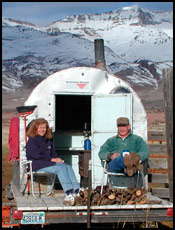
Ron Torell with his wife, Jackie.
Cow Camp Chatter
Technological tools of the trade
Modern technology and the products that we take for granted, such as computers with high-speed Internet access, iPods, GPS, PDAs and cell phones, would be fascinating to generations gone by. Computers are no longer new technology, but a given in the educational system and business world. It's astonishing that almost every child graduating from high school today will have been educated by way of computers beginning as early as preschool. Which of these modern-day innovations fascinates you the most?
For some it's none of the above. It's human nature to resist change and stick with what we are comfortable. Due to cost, tradition or simply stubborn nature, those who are reluctant to go along with the new-fangled technology take on tasks the hard way knowing there are tools available that may simplify their work.
Imagine the amazement of the cave man as the first wheel rolled off the assembly line. This fascination with new technology probably received the same level of both amazement and initial resistance throughout time as new technology does today. The wheel led to the human-drawn pull cart, which led to the horse-drawn cart, which led to the motorized vehicle.
Beef technologies
The beef industry has gone through a similar evolution brought on by technology. Following is a chronological short list of technologies that have helped shape the U.S. beef industry during the past 150 years. The list is certainly not all-inclusive, yet it hits the high points.
| 1868 | Refrigerated rail car units introduced |
| 1920s | Official grading of beef carcasses begins |
| 1930s | Beef cattle improvement research initiated |
| Artificial insemination of cattle commercialized | |
| 1940s | Antibiotic and vaccine development for livestock |
| First heritability estimates for beef cattle traits published | |
| 1950s | First successful transfer of a bovine embryo made |
| First successful conception utilizing frozen semen | |
| 1960s | Acceptance and use of growth-promoting implants |
| 1970s | First ionophore introduced for enhancing feed efficiency |
| First prostaglandin approved for synchronization of estrus | |
| First calf born in the United States from a frozen embryo | |
| Mandatory brucellosis vaccination program initiated | |
| 1980s | Anthelmintic product development to effectively control parasites |
| Refinement of antibiotics and vaccines | |
| First identical twin calves born in the United States from embryo splitting |
|
| Expected progeny differences (EPDs) gained acceptance | |
| Satellite auctions introduced | |
| 1990s | Ultrasound technology accepted |
| Check-off funded convenience products developed and introduced | |
| DNA technology utilized | |
| 2000s | Computers, cell phones and email used widely by industry |
| Sexed semen available commercially | |
| Internet auctions gain popularity | |
| Electronic identification capabilities introduced to the industry | |
| Instrument grading introduced to packing industry | |
| Genomic-enhanced EPDs accepted and utilized | |
| Heat synchronization protocols refined | |
| GPS technology widely used in agriculture |
What have you incorporated into your operation from this list? Satellite auctions, for example, were very slow to catch on in the early 1980s. Now the majority of truckload lots of cattle are marketed in this manner. Is Internet marketing the next generational jump in technology? Ask yourself what you are willing to accept now or in the future.
In the beef industry, we often hear about some professor, company or corporate ranch manager with their vision or use of electronic identification, DNA testing, ultrasound, individual recordkeeping systems or computer programs that aid the producer in profitable beef cow management. If we aren't already using this new technology, we often question if we should be.
Much of this technology requires the quantity of cattle to make it economically viable and also requires facilities and labor adequate enough to support the technology. Not every operation is created equal, so just because a new technology works for one ranch does not necessarily mean it will economically benefit another.
Not a substitute
All the technology in the world is no substitute for understanding and managing the basic needs of the beef cow. It's important to keep in perspective that it's technology that has changed and not the science and husbandry of the ruminant. The basic principles and understanding of beef cow management must be in place prior to successfully implementing these new tools.
Applying new technology prior to having a solid understanding of the beef cow coupled with experience in ranch management is a good way to go broke fast. Not adopting some technologies is also a good way to go broke. There needs to be a balance. Bottom line, not all new technology is for every operation. Sometimes taking a cautious, wait-and-see approach is warranted.
On a personal level, my recent exposure to a crawler-mounted hydraulic corner-post pounder borrowed from a neighbor was an easy technology for me to embrace. I know now that there is a better tool for the job than my shovel and bar for digging holes.
That's enough for this month. A special thanks to my wife, Jackie, for her part in writing "Cow Camp Chatter." As always, if you would like to discuss this article or simply want to talk cows, do not hesitate to contact me at 775-385-7665 or e-mail me.











